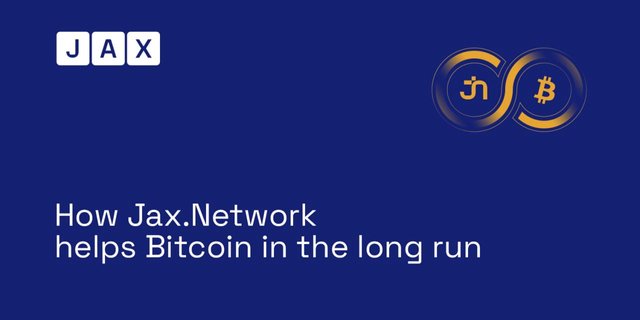JAX Network - A Scalable, Decentralized Stablecoin for DeFi
Decentralized Stablecoin for Defi
Jax.Network is tethered to the BTC blockchain which follows the JaxNet protocol and issues a scalable, stable and decentralized JAX coin. We aim to make these coins the universal standard for the quantification of economic value.
Abstract
Today’s world is organized based on merit and value. A single global currency
that’s decentralized is needed for a global economy. Bitcoin is a partial solution
to this need, however it suffers from scalability problems which prevent it from
being mass-adopted. Also, the deflationary nature of bitcoin motivates people to
hoard and speculate on them instead of using them for day to day transactions. We
propose a scalable, decentralized cryptocurrency that is based on Proof of Work.
The solution involves having parallel chains in a closed network using a mechanism
which rewards miners proportional to their effort in maintaining the network. The
proposed design introduces a novel approach for solving the scalability problem in
the blockchain network based on merged mining.
Index terms: blockchain, scalability, sharding,
merged-mining, distributed networks
.jpeg)
Governments, through their monetary policies, influence the value of a currency. A person
could work for her entire life, save a part of her wealth in their currency and lose everything
overnight when the currency collapses due to bad monetary policy.
If this is less probable to occur in well manage countries with sound institutions, bad
money is still a fact. People from some developing nations, although very productive,
∗
iuriijax.net
†vinodjax.network
‡
tarasjax.network
§
lucasylegergmail.com
After the launch of the Bitcoin network [67], we witness with its exponential capitalization
growth a Cambrian explosion of new altcoins. Naturally, a new question arose: could
BTC (or any of its numerous rivals), become an universal global currency with cheap
maintenance? Could it be made fast and acceptable even for small transactions in any
gas-station, fast-food, or apparel shop, as well as secure and reliable for big transactions
between large corporations? What about big, complicated, long term contracts like those
for cargo ships, opening a credit line, or setting supply chain contracts?
Among the leading problems are legislation, the position of the financial market’s
regulators, and the attitude of individual suppliers and consumers. However, there are
more technical obstacles on the way to mass adoption. All together, these obstacles are
commonly called scalability problem in distributed system. Another name for this problem
is Scalability Trilemma. This term was introduced by the co-founder of the Ethereum
project Vitaliy Buterin. [34, 36, 68]
When the size of the distributed system grows it requires more maintenance. If a given
blockchain network becomes more global, then it should, on the one hand, have billions of
wallets and execute billions of transactions every day. So, it should be rather powerful to
handle these transactions throughout and store part of the transaction history required
for thorough verification. On the other hand, this system should be friendly enough for
small nodes to help maintain the network with their limited resources.
Such a system should be convenient for users in terms of short confirmation time,
easy and reliable transactions, and with low fees. Overall, distributed networks should
be decentralized, and thus be an alternative to classical solutions of the problem through
decentralization. Even though blockchain technology widely uses some sophisticated tech-
niques to record, maintain, and validate data like encryption, hashes, and Merkle trees,
there are still significant limitations.
How Jax.Network helps Bitcoin in the long run
Despite the recent bull run and surge in cryptocurrency popularity, limitations of Bitcoin remain the same. We at Jax.Network are determined to bring value to the Bitcoin network by improving its core issues: scalability and stability. Read the article till the end to learn how we intend to do it.

Limitations of Bitcoin
It goes without saying that blockchain, lying in the basis of Bitcoin, is a truly remarkable and revolutionary technology that is set to change the current state of affairs. Well, these changes are actually noticeable, as a wide range of useful applications has been constructed on top of it. But what about Bitcoin? Several projects have been working on bringing scalability (e.g. Lightning), smart contracts (Rootstock), or aiming at decreasing transaction fees (Taproot update). However, Lightning has some issues, and Bitcoin is still seen as an asset, hence, very volatile.
So, scalability has remained an Achilles’ heel for truly decentralized cryptocurrencies since day one till today, no matter how hard other projects tried to address this issue. With regard to Bitcoin, scalability, or lack thereof, is the Bitcoin blockchain network’s limited rate at which it can process transactions. The Bitcoin network can process approximately 7 transactions per second — an obviously unsuitable number. The reason for the lack of scalability is due to the designs in the Bitcoin protocol. It allows miners in the network to validate the transactions on only a single chain.
The second major issue is volatility. We understand that this is something speculators, investors and traders worship, but at the same time, it is something that makes Bitcoin unsuitable as a day-to-day currency or payment platform. Despite the recent upward rally of Bitcoin, there have been many occasions where it has fallen a great amount just as quickly.
It is due to its volatility that customers and users do not want to transact with it and merchants do not want to accept it. As for crypto users, they still prefer stablecoins for transactions. There are of course exceptions, but generally, the vast change in price, even within 24 hours is too much for it to be used as a day-to-day payment method.
How we bring scalability and stability to the Bitcoin network
As you already know, we recently added Bitcoin as the anchor shard. This solution allows BTC miners to merge-mine Jax.Network and earn extra fees from JXN and JAX transactions. Although we would like to highlight that it also brings scalability and stability to the Bitcoin ecosystem in a decentralized way. Jax.Network uses sharding to increase the scalability of our blockchain network and, hence, the Bitcoin network. This technology allows us to split a large data set, such as a full blockchain ledger, that is then run independently in parallel with each other. As a result, we get an increased number of transactions on the blockchain network in proportion to the number of shards.
Until today, BTC miners have been affected by the volatility of the coin and their mining profits have been mainly based on its performance. By implementing merge-mining and bringing transactional utility to the Bitcoin ecosystem, we allow BTC miners to build long-term business models based on predictable transaction fees. We believe that this will help the mining industry evolve. On top of that, we introduce JAX stablecoin to the Bitcoin network. The design of JAX is innovative and does not rely on external data sources, a peg, or some collateral to function. It’s purely based on economic incentives provided by our reward function and the economics behind the PoW consensus algorithm.
We also have to mention that BTC miners fully rely on the speculative value of the Bitcoin network at the moment. This means that the miners who are mining at $0.07 cents or above will have to turn off the rigs when the BTC price drops below a certain extent. Most sustainable mining happens at the $0.04 cents level. However, even this is very dangerous in a speculative market. And, if the price of BTC crashes and the hashrate has to be turned off to stay in business, it will create extra risks, as the network will now be more prone to double-spend attacks caused by a great drop in the security cost.
We have created the network that benefits miners in multiple ways. So, as the Bitcoin reward moves closer towards zero in the future, miners will still have an incentive to share the network hashrate with the Bitcoin network for additional transaction fees and this ensures that the transaction fees across both networks are always minimal.
Conclusion
Since Jax.Network brings scalability and stability to the Bitcoin network, it will be a huge boost for the entire ecosystem and the miners who don’t merge-mine Jax.Network with BTC will be at a disadvantage. Whichever miner missed out on the early BTC adoption has a chance to get into Jax.Network adoption now and capture value by providing critical mining services.
Don’t miss any announcement by subscribing to our social media accounts:
Author
Lasma33
https://bitcointalk.org/index.php?action=profile;u=2185647


Komentar
Posting Komentar